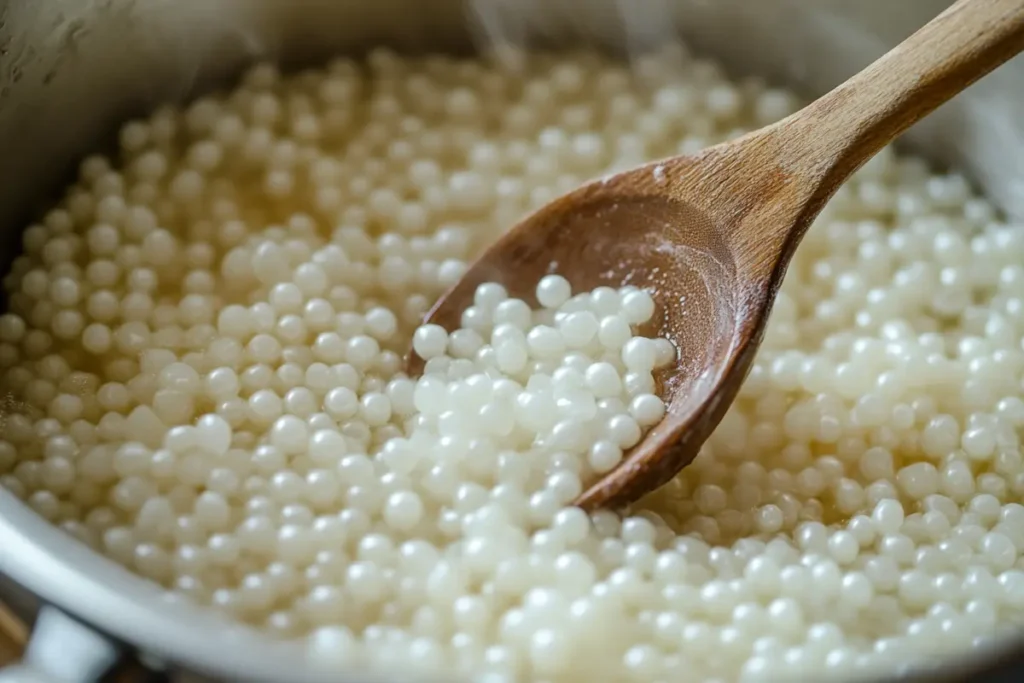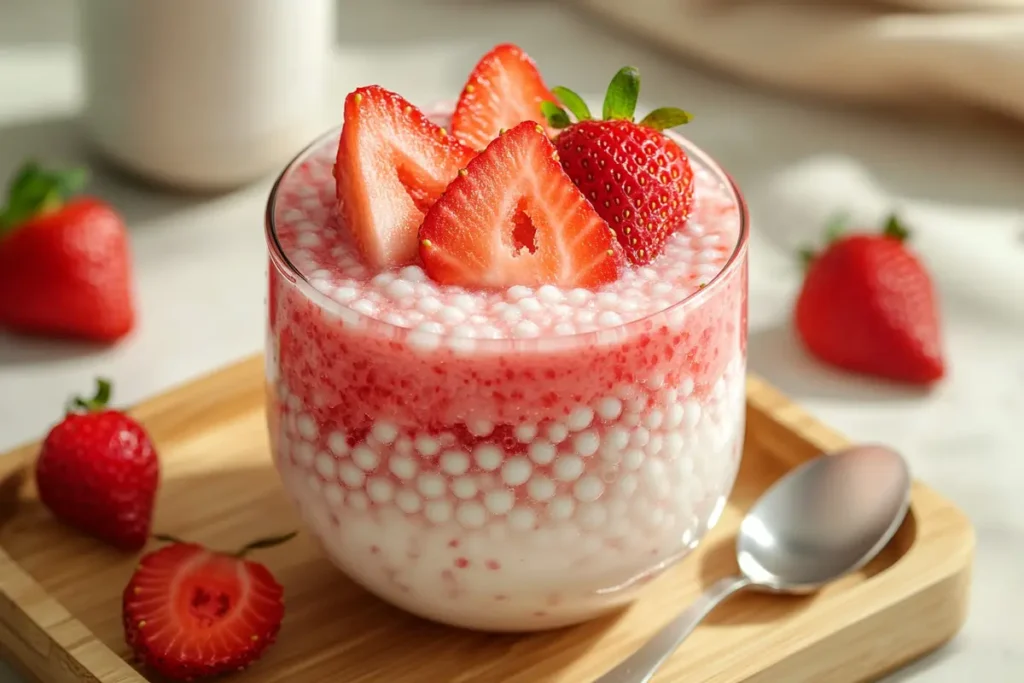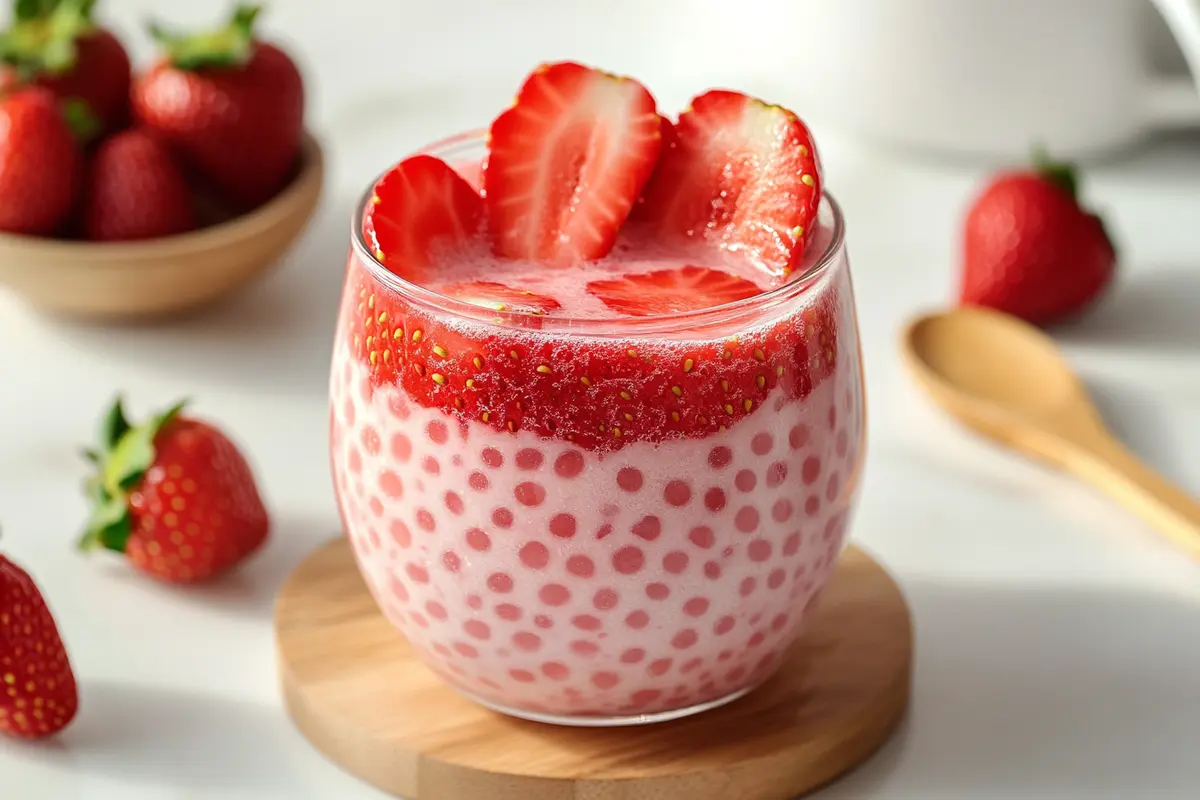I still remember the first time I made strawberry sago. It was a humid summer evening, and I craved something cool, sweet, and refreshing. I had fresh strawberries sitting in my fridge, a packet of sago pearls I bought on impulse, and a can of coconut milk tucked away in my pantry. I didn’t follow a recipe—I just went with my gut. The result? A creamy, chewy, and fruity dessert that instantly became my go-to treat.
Since then, I’ve perfected this strawberry sago recipe, balancing the flavors and textures to make it absolutely irresistible. If you love tapioca desserts, coconut-infused sweets, or just need a light, refreshing treat, this one’s for you. Let’s dive in!
Introduction to Strawberry Sago
What is Strawberry Sago?
Strawberry sago is a chilled Southeast Asian dessert made with sago pearls, fresh strawberries, and a creamy milk base. It’s sweet, slightly chewy, and incredibly refreshing—perfect for warm weather or as a light after-dinner treat. The combination of nata de coco, evaporated milk, and condensed milk gives it an irresistible richness while keeping it light.
Why is it Popular in Asian Desserts?
Sago pearls are a staple in many Asian desserts, from mango sago to coconut-based puddings. Their chewy, jelly-like texture adds a fun twist to creamy desserts. Strawberry sago takes this concept to the next level by adding the natural sweetness and slight tartness of fresh strawberries, making it an instant crowd-pleaser.
The Perfect Summer Treat: Light, Creamy, and Refreshing
What makes strawberry sago special? It’s not just about the flavors—it’s about how they come together. The soft, chewy sago pearls soak up the strawberry-infused milk, creating a dessert that’s creamy but not heavy, sweet but not overpowering. Serve it cold, and you’ve got the ultimate summer treat!
Ingredients & Substitutions
I remember a time when I excitedly prepared strawberry sago for a family gathering, only to realize I had run out of coconut milk! Instead of panicking, I experimented with different substitutes and discovered that this dessert is incredibly versatile. Whether you’re using traditional ingredients or switching things up, you can still create a delicious treat.
Essential Ingredients for Strawberry Sago
To make this creamy, refreshing strawberry sago recipe, you’ll need:
- Sago pearls – These tiny, chewy pearls add a delightful texture.
- Fresh strawberries – They provide natural sweetness and a hint of tartness.
- Coconut milk or cream – This creates the rich, creamy base.
- Condensed milk – Adds sweetness and enhances the flavor.
- Evaporated milk – Balances the richness of the coconut milk.
- Nata de coco or coconut jelly – A fun, chewy addition.
- Sugar or honey – To adjust the sweetness.
- Ice cubes – Keeps the dessert perfectly chilled.
Best Strawberry Varieties for This Recipe
The type of strawberries you use can make a big difference! Fresh, ripe strawberries are ideal for their natural sweetness. Look for:
- Albion or Seascape strawberries – Naturally sweet and juicy.
- Chandler strawberries – Slightly tart but great for balancing flavors.
- Frozen strawberries – A good alternative if fresh ones aren’t available. Just thaw and blend them well.
Alternative Sweeteners & Dairy-Free Options
Want a dairy-free or healthier version of this strawberry sago recipe? Try these swaps:
- Coconut sugar or maple syrup instead of condensed milk.
- Almond or oat milk in place of evaporated milk.
- Coconut cream for extra richness without dairy.
Where to Buy Sago Pearls & Coconut Jelly?
You can find sago pearls and nata de coco at most Asian grocery stores or order them online. Look for quick-cooking sago pearls if you want to cut down on cooking time.
Step-by-Step Guide to Making Strawberry Sago
The first time I made strawberry sago, I didn’t rinse the cooked sago pearls properly—big mistake! They clumped together, turning into a sticky mess. Since then, I’ve perfected the process, and I’m sharing my foolproof method with you.
Preparing the Sago Pearls – Cooking Tips & Tricks

Cooking sago pearls the right way is crucial for a smooth texture. Follow these steps:
- Boil water – Use a large pot since sago expands.
- Add sago pearls – Stir continuously to prevent sticking.
- Cook for 10–15 minutes – The pearls should turn translucent with a small white center.
- Turn off heat and cover – Let the pearls sit for another 10 minutes.
- Rinse under cold water – This stops the cooking process and removes excess starch.
Making the Strawberry Puree for Maximum Flavor
For the best strawberry flavor, make a fresh puree:
- Blend fresh strawberries with a little sugar or honey.
- Strain the mixture if you prefer a smoother texture.
- Chill the puree before mixing for a refreshing taste.
Combining Ingredients for the Perfect Texture

Now, it’s time to assemble your strawberry sago:
- Mix coconut milk, evaporated milk, and condensed milk in a bowl.
- Add the chilled strawberry puree for a vibrant color and taste.
- Stir in the cooked sago pearls and mix well.
- Fold in nata de coco or coconut jelly for extra chewiness.
How to Chill & Serve for the Best Taste
- Refrigerate for at least 1 hour before serving.
- Serve with ice cubes for an extra cold, refreshing treat.
- Garnish with fresh strawberry slices to enhance presentation.
Variations of Strawberry Sago
Over the years, I’ve experimented with different twists on the classic strawberry sago recipe. Sometimes, I swap ingredients based on what I have on hand, and other times, I tweak the flavors for a new experience. Here are some exciting variations you can try!
Classic Strawberry Sago with Coconut Milk
If you love the traditional taste, stick with coconut milk as the base. This version is:
- Creamy, rich, and slightly tropical.
- Made by blending fresh strawberries into the coconut milk mixture.
- Sweetened with condensed milk for a balanced flavor.
Serve it cold, and you’ll have a perfect refreshing summer dessert!
Strawberry Sago with Nata de Coco & Jelly
Adding nata de coco and fruit jelly takes this dessert to another level! This variation:
- Combines chewy coconut jellies for added texture.
- Includes small cubes of strawberry-flavored jelly for extra fruitiness.
- Works great with lychee jelly or mango jelly for a tropical mix.
If you enjoy boba-inspired desserts, this version is a must-try!
Vegan & Dairy-Free Strawberry Sago
Need a plant-based alternative? No problem! Replace:
- Condensed milk with coconut condensed milk or maple syrup.
- Evaporated milk with almond, soy, or oat milk.
- Regular coconut milk with light coconut milk for a less rich taste.
The result? A 100% dairy-free strawberry sago recipe that’s just as creamy and delicious.
Chocolate or Matcha Twist – Creative Variations
Feeling adventurous? Try these:
- Chocolate Strawberry Sago – Add 1 tbsp of cocoa powder to the coconut milk.
- Matcha Strawberry Sago – Mix 1 tsp of matcha powder into the milk for an earthy, slightly bitter contrast.
Both of these flavors complement the natural sweetness of strawberries, making them unique yet familiar!
Tips for the Perfect Strawberry Sago
The first time I made strawberry sago, I underestimated how quickly sago pearls could overcook. They turned into a gluey mess! After several tries, I’ve picked up some key tricks to get it just right.
How to Prevent Sago Pearls from Clumping?
The secret to chewy, separate pearls is proper cooking and rinsing:
- Stir constantly while boiling to avoid sticking.
- Use plenty of water—sago expands as it cooks.
- Rinse under cold water immediately after cooking to remove excess starch.
If your sago pearls get too sticky, just soak them in cold water for a few minutes, and they’ll loosen up!
Balancing Sweetness – Adjusting to Your Preference
Not everyone loves super-sweet desserts. Here’s how to adjust:
- Add less condensed milk if you prefer a mild sweetness.
- Use honey or agave syrup for a natural alternative.
- Try strawberry-flavored oat milk instead of condensed milk for a subtle fruitiness.
Serving & Storage Tips for Freshness

For the best experience, serve your strawberry sago fresh! However, if you need to store it:
- Keep it in an airtight container in the fridge for up to 2 days.
- Stir well before serving—sago pearls absorb liquid over time.
- Add fresh strawberry slices before serving to enhance flavor and texture.
Common Mistakes & How to Avoid Them
- Overcooking sago – Always follow the timing and let it rest off-heat.
- Skipping the rinse step – This results in gummy, clumped pearls.
- Not chilling long enough – The flavors develop better after at least an hour in the fridge
FAQs
Over time, I’ve received so many questions about making the perfect strawberry sago recipe. Whether it’s about ingredient swaps, storage, or troubleshooting common mistakes, I’ve got you covered! Here are some frequently asked questions with detailed answers.
How long does strawberry sago last in the fridge?
You can store strawberry sago in an airtight container in the fridge for up to two days. However, the sago pearls will continue absorbing liquid, which may affect the texture. If it thickens too much, simply stir in a splash of coconut milk or evaporated milk before serving.
Can I use frozen strawberries instead of fresh ones?
Absolutely! Frozen strawberries work well in this strawberry sago recipe, especially when fresh ones aren’t available. Just let them thaw slightly before blending. If they release too much liquid, adjust the consistency by adding a little less coconut milk.
What’s the difference between sago and tapioca pearls?
While they look similar, sago pearls and tapioca pearls come from different sources:
- Sago pearls are made from the starch of tropical palm stems.
- Tapioca pearls are derived from cassava root starch.
Both have a chewy texture, but tapioca pearls are often larger and take longer to cook. For this strawberry sago recipe, use small sago pearls to get that smooth, pudding-like consistency.
Is strawberry sago gluten-free?
Yes! Sago pearls, coconut milk, and fresh strawberries are naturally gluten-free, making this dessert a great option for anyone with gluten sensitivities. Just be sure to check labels on store-bought nata de coco or sweetened condensed milk to confirm they are gluten-free.
Conclusion – Why You’ll Love This Strawberry Sago Recipe
I’ve made this strawberry sago recipe countless times, and it never fails to impress. Whether you’re preparing it for a family gathering or just craving a refreshing summer dessert, this recipe delivers a perfect balance of sweet, creamy, and chewy textures.
Here’s why you should try it:
- It’s easy to make with just a few ingredients.
- You can customize it with different toppings or milk alternatives.
- It’s naturally gluten-free and can be made dairy-free.
- The chilled, creamy texture makes it ideal for hot days.
Now it’s your turn! Gather your ingredients, follow the steps, and enjoy a homemade strawberry sago dessert. If you try this recipe, let me know how it turned out—I’d love to hear your thoughts!

